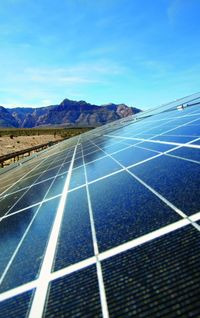Italy’s renewables market is on a steady growth curve, with growing interest from international investors, sometimes supported and sometimes challenged by local regulations. Trends and ideas were discussed at the latest Italian Renewables Investment Forum held in October. By Daria Buonfiglio, head of strategic marketing and communications, Green Horse Legal Advisory
In the past five years, the Italian renewable energy market has grown significantly, thanks in part to numerous projects funded by international investors. Italy has set an ambitious target in its Integrated National Energy and Climate Plan (PNIEC) to cover 65% of its electricity demand with renewable energy by 2030.
This is a challenging goal, considering that currently, the share of renewable energy in Italy is at 36.8%, still far from that of other European countries such as Spain (52%), and Germany (50%). Italy has all the potential to achieve this goal, given the growth trends in installed renewable capacity, but it will inevitably face obstacles in the current regulatory framework.
"The latest data available on the growth of installed capacity is certainly positive. Since the beginning of the year, nearly 5GW has been installed, although we are still far from the 8GW needed annually to meet the 2030 targets. This is an encouraging result, demonstrating the vitality of a sector crucial to our country's system," said Carlo Montella, co-founder and managing partner of Green Horse Legal Advisory.
"This achievement is the result of investments made in recent years, largely attributable to international investors, despite the lengthy authorisation processes. Unfortunately, the current regulatory framework risks making these processes even longer and more complex. We must therefore expect a slowdown in investment growth, with repercussions on installed capacity that will become even more evident starting in 2026.
"This is a shame as the Italian renewable energy market would be one of the most attractive targets in Europe and even globally mainly due to the expected material increase of the energy demand in the next years – electrification of final-end consumption, electrical mobility, data centres – which would require a significant incremental renewable energy capacity being able to catch high long-term contracted revenues based on CfD mechanisms. Not to consider that such new solar and wind capacity should be combined with new BESS installations and other new grid infrastructures."
These topics were discussed at the Italian Renewables Investment Forum 2024, an event organised by Green Horse Advisory and Althesys at the Maxxi Museum in Rome, which brought together the leading national and international investors in the renewable energy sector. The event was in its second edition and brought together over 300 professionals from 210 companies across the renewable energy spectrum, including leading investors, utilities, independent power producers, and developers, engineering, procurement, and construction firms, as well as debt providers.
The meeting was attended by representatives from institutions and top management of major Italian players including: Federico Boschi, head of the Energy Department at the Ministry for Ecological Transition (MASE); Gianni Vittorio Armani, director of Enel Grid; Francesco Del Pizzo, director of Network Development Strategies and Dispatching at Terna; Gaetano Armao, president of the CTS for Environmental Authorizations of the Sicilian region; Paolo Arrigoni, president of GSE; Salvatore Bernabei, CEO of Enel Green Power; Luca Dal Fabbro, president of Iren; Alessandro Della Zoppa, head of Renewables at Eni Plenitude; Pier Lorenzo Dell’Orco, CEO of Italgas Reti; Toni Volpe CEO of Nadara; Giuseppe Argirò, CEO of CVA; Filippo Rigoni, co-founder and President of Zhero; and Elisabeth Rizzotti, founder and COO of Newcleo Italy.
The forum underscored the substantial potential of Italy’s renewables sector, which, however, must address changes in regulatory frameworks, updates to grid infrastructure, and the development of technology-driven supply chains to fully exploit its potential and achieve its ambitious net-zero emissions target by 2050. Here, we explore the primary insights shared during the event.
Regulatory framework
A recurring theme was the regulatory landscape governing renewable energy investments in Italy. Although nearly 5GW of new renewable capacity was installed by August 2024 – primarily driven by solar projects – investors remain cautious due to bureaucratic delays and policy uncertainty. Italy’s renewables sector has encountered significant authorisation delays that can deter both domestic and international investors. The sector’s future stability depends on the swift resolution of these challenges, especially as investors become more concerned about Italy’s commitment to creating a conducive investment environment.
The forum particularly highlighted recent regulatory changes, such as the DL Agriculture and the eligible areas decree, which add complexity to an already challenging regulatory landscape. Domestic and international investors have expressed concerns that these adjustments could reduce investment flows unless revisions are implemented in a timely manner. Such regulatory bottlenecks, if not managed, could risk derailing Italy’s 2030 and 2050 climate goals.
“Our investor clients have confirmed a strong interest in investing in our country, provided that the regulatory environment allows for long-term investments based on clear and consistent rules. Changes to the regulatory framework that are partly retroactive and inconsistent with the regulatory setup and direction established in recent years undermine our country’s credibility,” said Andrea Gentili, partner at Green Horse Legal Advisory.
One encouraging sign came in the form of updates on the regional decrees regarding eligible areas, with a specific focus on Sicily. The Sicilian government’s commitment to finalising guidelines by the end of the year was well received by investors, signalling potential stabilisation in the regulatory environment. For stakeholders, a transparent and consistent framework is critical to fostering long-term confidence in the Italian renewables market, allowing them to plan and secure financing with fewer risks of delay.
Long-term remuneration
Long-term remuneration schemes, such as those outlined in the FER X and FER 2 decrees, are viewed as instrumental for Italy’s renewable market. These policies have the potential to catalyse investment across various segments of the industry. However, their delayed implementation has left investors in a state of anticipation, awaiting concrete steps forward. During the forum, Boschi explained that total capacity incentivised under the FER X decree would fluctuate depending on installations outside the incentivised mechanism, including energy release, merchant initiatives, and PPAs.
FER X and FER 2 are not only necessary for project developers but also serve as essential tools for the broader project finance market. By providing consistent remuneration for renewable projects, these schemes lower financing risks, making projects more attractive to traditional financial institutions.
Banks have consistently expressed interest in supporting projects with stable remuneration. Lack of support mechanisms in recent years have led banks to adopt a cautious approach, often requiring substantial guarantees before extending credit to renewable projects. Gentili said: "The introduction of FER X, along with lower interest rates, are expected to encourage banks to reengage more confidently, positioning them as key players alongside debt funds.”
“With specific respect to solar projects, the firm has also observed that investors are increasing their appetite for PPAs, which are seen as a practical response to regulated remuneration schemes delays, providing operators with a way to secure revenue while awaiting policy implementation,” said Gentili.
Some operators with authorised projects are facing stalemates due to FER X exclusions for projects already under construction and this has led to heightened interest in the PPA market as a viable alternative, allowing projects to proceed without further delays.
Gas-fired generation and storage
Although renewable energy is increasingly prominent, gas-fired generation continues to play an essential role in Italy’s energy mix. The forum recognised that, at least in the medium term, gas will be crucial for grid stability, particularly during periods of low renewable output. As renewable capacity expands, complementary investments in both storage and grid infrastructure are also seen as essential to integrating renewables effectively and minimising reliance on fossil fuels.
Storage, while still emerging, is attracting significant interest. Terna’s announcement regarding Italy’s first storage capacity auction, MACSE, set for early 2025, marked a significant step forward.
“Italy’s reliance on intermittent renewable sources like solar and wind necessitates robust storage solutions to ensure grid stability. The MACSE auctions are anticipated to play a pivotal role in enhancing the nation’s storage infrastructure, further integrating renewables into Italy’s energy mix while offering new avenues for investment,” said Iacopo Magrini, CEO at Green Horse Engineering.
He added: “The MACSE scheme likely represents investors' first exposure to these new types of plants, offering a relatively safe environment to explore this emerging frontier. With the anticipated growth in renewable energy adoption and operators gaining confidence in this technology, it is both probable and desirable that storage systems will eventually operate efficiently within a merchant scheme. This evolution could potentially include the use of technologies beyond traditional batteries.”
Energy demand
As Italy embraces electrification, energy demand is set to rise substantially. Domenico Vinci, CEO at Green Horse Financial Advisory noted that “several factors are contributing to this increase, including the proliferation of data centres, electrification of end-use consumption, the adoption of electric mobility, and climate change”.
PNIEC has set ambitious targets for 2030, aiming for a renewable-centric energy system that will power a significant portion of this future demand. This shift will have implications for energy prices, which are expected to remain relatively high in the near term due to Italy’s reliance on gas imports.
“Unlike other European markets, Italy is less prone to negative pricing scenarios resulting from renewable energy oversupply. This is primarily due to Italy’s ongoing dependence on natural gas, which stabilises prices and offers a more predictable investment environment. For investors, this relative stability presents a favourable outlook compared to other markets where renewables can drive prices into negative territory. As such, Italy’s energy landscape continues to attract foreign capital, despite regulatory uncertainties that persist,” Vinci added.
Solar trends
Green Horse Advisory’s analysis indicates solar energy remains a top area of interest for international investors in Italy. "Notably, there is a trend toward smaller projects around or below 20MW compared to the previously preferred large-scale projects in Southern Italy. This shift is driven by several factors, including simplified permitting procedures introduced by recent legislation and a greater willingness among local administrations to approve smaller installations. Additionally, smaller projects in Central-Northern Italy experience fewer grid congestion issues and a reduced risk of curtailment,” Gentili said.
Offshore wind
The forum discussed offshore wind as one of Italy’s most promising, albeit challenging, renewable technologies. Floating wind farms, in particular, present an opportunity to harness Italy’s vast coastline. However, capacity targets set by Italy’s PNIEC and incentivised by the FER 2 decree are not sufficient to unlock this sector’s full potential. Major hurdles include the development of a robust supply chain, port infrastructure, and logistics capabilities.
Italy’s extensive coastline provides an ideal setting for offshore wind development, especially floating technology that can be deployed in deep waters. Yet, without investment in infrastructure such as ports capable of handling large offshore components, this potential remains largely untapped. Addressing these challenges will be crucial if Italy hopes to build a competitive, sustainable offshore wind sector capable of contributing meaningfully to its climate goals.
Hydrogen
Hydrogen emerged as another promising but nascent technology. As a potential energy carrier for decarbonising sectors like heavy transport and hard-to-abate sectors, hydrogen is being explored worldwide. However, in Italy, the development of a hydrogen economy is still in its early stages, with several economic and logistical obstacles. High electricity costs and competition with other low-carbon solutions may hinder its near-term feasibility.
Despite these hurdles, Italy has ambitious plans to build a hydrogen sector that could support industries where electrification is not feasible. The forum emphasised that much foundational work is needed, including significant infrastructure investment, to establish a viable market. As Italy moves forward, the integration of hydrogen within its broader energy strategy will require careful planning and substantial investment.
The profile of new investors
Green Horse Advisory expects specialised energy funds and infrastructure investors will remain central to Italy’s renewables market. As the secondary market for incentivised plants nears the end of its cycle, new investments are focusing on assets under construction. Investors with a higher risk tolerance, particularly those experienced in managing construction and operational risks, are leading these investments.
Gentili commented: “Institutional investors, such as insurance and pension funds, which generally prefer lower-risk profiles, are expected to become more active in two to three years as more operational assets become available.”
Financial institutions
Financial institutions, as has always been the case, will play a critical role in the energy transition, both in the short and long term. As also represented by the other stakeholders of such transition, in order to foster financial transactions, Italy needs to count on a stable and coherent regulatory framework. This includes clear regulations governing the interim periods between different incentive schemes, which are crucial for structuring financing transactions, particularly in the context of project finance.
In this regard, as also stated above, the FER X and FER 2 draft decrees represent a significant opportunity for both investors and lenders. The incentive schemes outlined in these decrees are designed to enable the structuring of financing based on long-term and stable project revenues, while also mitigating counterparty risk, given that the incentives are granted by public authorities.
Another key consideration for financial institutions is the state of national energy connection and transportation infrastructure. Delays in the development and construction of these facilities can adversely impact project cashflows.
Maria Teresa Solaro, partner of project and structured finance at Green Horse Legal Advisory, commented: "Although regulatory uncertainties and legislative discrepancies between Italian regions persist, we are witnessing strong interest from the financial market in actively participating in the renewables and energy transition sectors. This includes not only commercial banks, both Italian and foreign, but also national and European public financial institutions, which are increasingly leveraging public [counter-]guarantee instruments regulated at national and European levels."
Based on Green Horse Advisory’s recent experience, financial institutions are increasingly open to evaluating new regulated markets for emerging technologies such as biomethane and BESS. These technologies often require more sophisticated financial structures, diverging from traditional construction or refinancing loans. They may involve short-term financing schemes (including mini-perm financing with a bullet payment at the end of the term) and debt sizing criteria tailored to theoretical ratios and theoretical repayment profiles, provided that standard market bankability and financial requirements are met.
In this context, Solaro noted: "We are also observing strong interest from the mezzanine loan market in supporting the renewable energy sector. This type of financing is increasingly used to bridge equity gaps, particularly during the development and construction phases, thereby addressing and anticipating the financial needs of investors."
Conclusion
This year's Italian Renewables Investment Forum underscored the optimism surrounding Italy’s renewable sector, which is driven by ambitious climate targets for 2030 and 2050 and high energy prices, positioning the country as a key player in the global renewable energy market. However, the event also highlighted the need for greater regulatory clarity, especially regarding authorisation processes and long-term remuneration schemes.
Investments in grid infrastructure and storage technologies will be critical for supporting the sector’s continued growth. First and foremost, Italy needs to pursue a systemic energy strategy involving all relevant stakeholders through a coherent and stable policy framework.
“Achieving the goals for new renewable capacity in the coming years, the need to install storage systems and build new grid infrastructure to support a more distributed production setup, the opportunity to develop and manage a new technology supply chain still being defined, and the need to integrate agriculture into the production of renewable gases and electricity – biomethane and agrivoltaics – require a comprehensive, strategic, coordinated, and systemic approach – one that has been lacking until now. Only with this approach can we achieve self-sufficiency and structurally reduce energy costs for families and businesses, Montella concluded:”
To see the digital version of this report, please click here.
To purchase printed copies or a PDF of this report, please email leonie.welss@lseg.com














